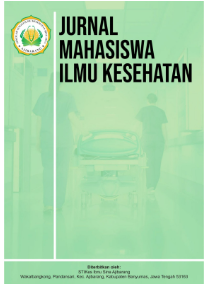Pengaruh Pola Makan terhadap Kejadian Karies Gigi Anak
DOI:
https://doi.org/10.59841/jumkes.v3i2.2354Keywords:
Children, Dental Caries, DietAbstract
Dental caries is a dental tissue disease characterized by tissue damage, starting from the surface of the tooth (grooves, fissures, and interproximal areas) extending towards (Braurer). Cariogenic foods are foods that can cause dental caries. The nature of cariogenic foods is that they contain lots of carbohydrates, are sticky and break down easily in the mouth. The purpose of this article is to determine the effect of food type, food frequency, and amount of food on the incidence of dental caries. The research method used was a literature review of various current scientific literature, including journals, textbooks and research articles. According to the results of research conducted by Febrian, et al., (2015), it shows that there is a significant relationship between types of cariogenic snacks and the incidence of caries. There is an influence of food frequency on the occurrence of dental caries in children. The amount of food consumed by a person or group of people at a certain time can trigger bacteria in the oral cavity to produce acid, causing the pH of saliva to decrease and demineralization to occur which will last for 30 to 40 minutes after eating.References
American Dental Association (ADA). (2018). Oral hygiene guidelines for children and adults. Retrieved from https://www.ada.org
Anonim. (2011). Karies gigi. Retrieved from http://repository.usu.ac.id./bitstream/123456789/16868/4/chapter%202011.pdf
Anonim. (2012). Pentingnya sikat gigi sebelum tidur. Retrieved from http://carahidupsehat.info/pentingnya-sikat-gigi-sebelum-tidur.html
Anonim. (2012). Retrieved from http://repository.usu.ac.id/bitstream/123456789/28136/5/chapter%201.pdf
Bowen, W. H., & Lawrence, R. A. (2019). Fluoride and dental caries prevention. Journal of Dental Research, 98(8), 837-846.
Featherstone, J. D. (2008). Dental caries: A dynamic disease process. Australian Dental Journal, 53(3), 286-291.
Febrian, R., Rasyid, R., & Noviantika, D. (2015). Analisis hubungan jenis dan frekuensi mengkonsumsi jajanan kariogenik dengan kejadian rampan karies pada anak usia 5-6 tahun di Kota Padang. Andalas Dental Journal.
Jeni, A. (n.d.). Dental caries. Retrieved from http://staff.ui.ac.id/internal/140142719/material/dentalcaries.pdf
Kementerian Kesehatan Republik Indonesia. (2017). Pedoman kesehatan gigi dan mulut untuk masyarakat. Jakarta: Kemenkes RI.
Marcenes, W., Kassebaum, N. J., Bernabé, E., Flaxman, A., Naghavi, M., Lopez, A., & Murray, C. J. (2013). Global burden of oral conditions in 1990–2010: A systematic analysis. Journal of Dental Research, 92(7), 592-597.
Petersen, P. E. (2008). World Health Organization global policy for improvement of oral health. International Dental Journal, 58(3), 115-121.
Selwitz, R. H., Ismail, A. I., & Pitts, N. B. (2007). Dental caries. The Lancet, 369(9555), 51-59.
Sheiham, A., & James, W. P. T. (2015). Diet and dental caries: The pivotal role of free sugars reemphasized. Journal of Dental Research, 94(10), 1341-1347.
WHO. (2020). Oral health fact sheet. Retrieved from https://www.who.int/news-room/fact-sheets/detail/oral-health
Zero, D. T. (2004). Sugars, acidogenicity, and dental caries. Journal of the American Dental Association, 135(1), 15-21.
Downloads
Published
How to Cite
Issue
Section
License
Copyright (c) 2025 Jurnal Mahasiswa Ilmu Kesehatan

This work is licensed under a Creative Commons Attribution-ShareAlike 4.0 International License.










